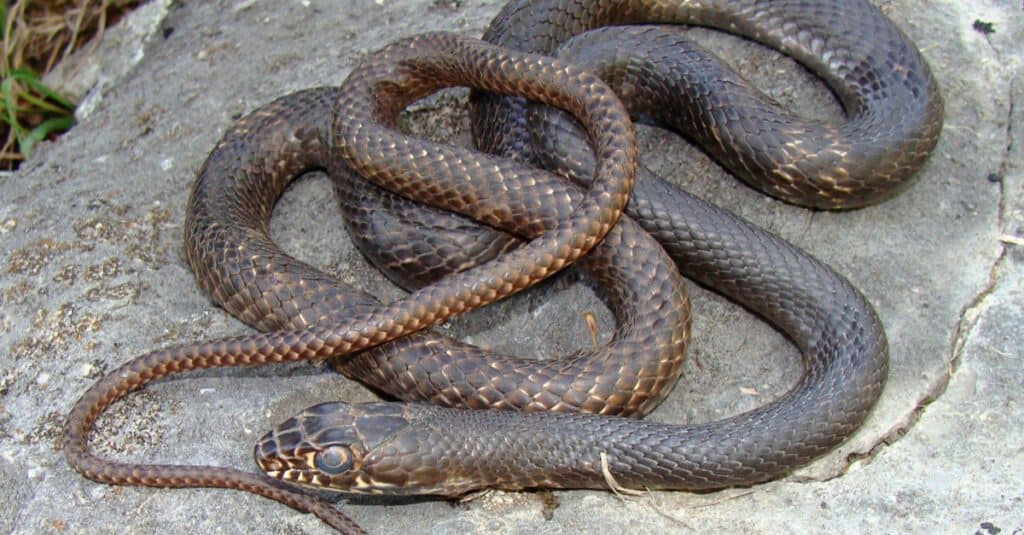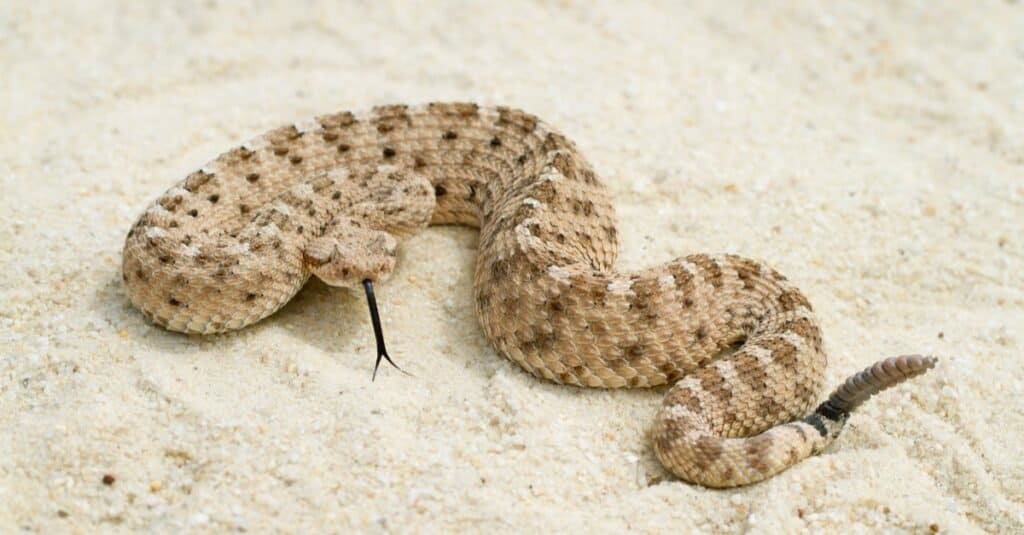Out of more than 50 species of snakes that can be found in the US, only a select few have the distinct honor of being the absolute fastest of the bunch. While other snakes may be impressive or unique due to their size, venom, or even lifespan, only the top three fastest snakes in the United States can move at truly unbelievable speeds. Below, we’ll take an in-depth look at all three, some interesting facts about each, and just how fast each one can slither.

3. Eastern/North American Racer (Coluber constrictor)

The eastern racer lacks venom, but it can move at speeds of up to around 3.5 miles per hour.
©Matt Jeppson/Shutterstock.com
True to its name, the North American racer doesn’t need venom to take down its prey. This is because it’s capable of moving at up to around 3.5 miles per hour, which is quite speedy for an animal lacking legs. Long and lean, this unique snake is a fast-moving, active hunter with exceptional eyesight. It’s also surprisingly strong for its size and equipped with a nasty-smelling musk it can spray from its cloaca to ward off the occasional predators that manage to catch up to it.
Native to much of North and Central America, eastern racer snakes are incredibly hardy and adaptable. They live in a wide range of habitats, as well as near water, though they prefer low, open grasslands. In addition to being quick on the ground, they’re also fairly skilled swimmers and climbers. As a result, the prey they feed on varies wildly, ranging from small rodents and amphibians to young birds, their eggs, and even the occasional fish.
Around 11 subspecies of eastern racers exist across North and Central America, with their coloration and patterning varying from one to the next. Most varieties, however, are mostly solid brown, black, or tan in color, usually with a much lighter-colored pale yellow or white underbelly. Notably, their tails typically lack any patterning whatsoever.
2. Coachwhip (Masticophis flagellum)

Long and incredibly lean, the speedy eastern coachwhip lives up to its name, being distinctly whip-like in appearance.
©Matt Jeppson/Shutterstock.com
The second-fastest snake in the United States is the coachwhip, also simply known as the whip snake, which has been clocked at speeds up to around four miles per hour. As its name implies, this non-venomous snake is especially long, slender, and whip-like in appearance. In addition to being one of America’s fastest snakes, it’s also among the longest, with the longest specimen ever recorded measuring 102 inches.
Six total subspecies of the coachwhip snake exist. They vary in color, but most are light to dark brown with flecked patterning that gives them a distinctly braided, rope-like appearance. Though they have small heads, their eyes are very large for their size. Collectively, these snakes inhabit much of the southern half of North America and Mexico. In general, they prefer dry, warm, sandy habitats like sandhill scrublands. However, they are also sometimes found in forests and prairies.
Because their bodies are so thin, coachwhips are unable to rely on constriction to subdue their prey. Instead, they simply ambush their prey and bite into the animal as tightly as possible, sometimes simply swallowing it whole. They mainly feed on small animals like lizards, birds, and rodents.
Perhaps in part due to its bizarre, whip-like appearance, many regional myths exist regarding the coachwhip. Despite this, though, coachwhips are harmless to humans and typically flee when approached rather than actively chase humans as some folklore and superstitions suggest.
1. Sidewinder (Crotalus cerastes) – The United States’ Fastest Snake

The sidewinder’s rough, textured scales and unique means of locomotion give it increased traction as it moves across flat, sandy deserts.
©Mark_Kostich/Shutterstock.com
The sidewinder is unique not only for being the fastest snake in North America–it’s also one of the fastest snakes in the world! Capable of reaching an astonishing speed of up to 18 miles per hour, the sidewinder gets its name from its unusual means of locomotion. It moves in a curved, J-shape, making it appear as if it’s slithering sideways. Researchers believe this unique method of movement gives the snake better traction when traversing the hilly, sandy deserts it most commonly inhabits.
Sidewinder snakes are native to the southwestern US in southern California, Nevada, and Arizona, as well as parts of Mexico. As a member of the Crotalus genus, it is a type of rattlesnake, and it is venomous. However, its venom is fairly weak when compared to most other members of its genus. Though it is incredibly fast, it is quite small, measuring just 15 to 30 inches long when fully grown.
The sidewinder’s rough, keeled scales typically match the desert substrates in which it lives. They can range from light tan to yellowish brown and even grayish brown in color. Atop each of its eyes is a large, pointy supraocular scale that helps to keep the bright desert sun and rough sand from obscuring its vision.
The photo featured at the top of this post is © Mark_Kostich/Shutterstock.com
Discover the "Monster" Snake 5X Bigger than an Anaconda
Every day A-Z Animals sends out some of the most incredible facts in the world from our free newsletter. Want to discover the 10 most beautiful snakes in the world, a "snake island" where you're never more than 3 feet from danger, or a "monster" snake 5X larger than an anaconda? Then sign up right now and you'll start receiving our daily newsletter absolutely free.
Thank you for reading! Have some feedback for us? Contact the AZ Animals editorial team.






